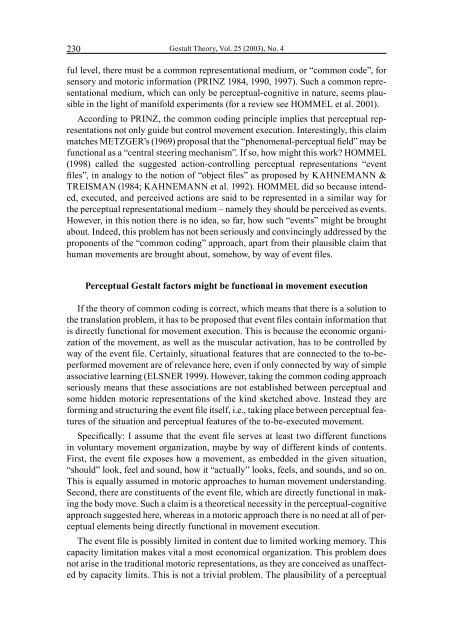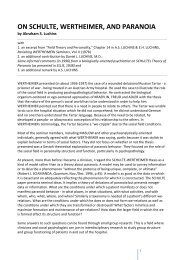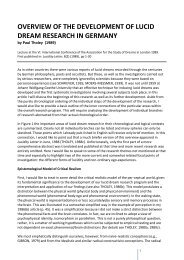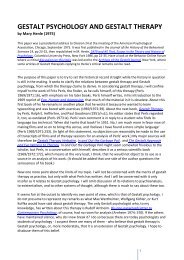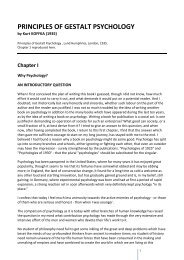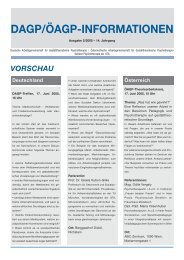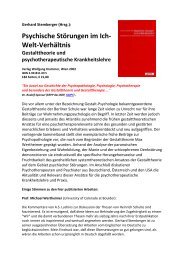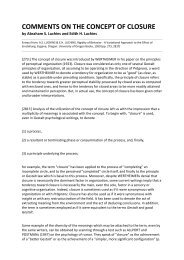230<strong>Gestalt</strong> Theory, Vol. 25 (2003), No. 4ful level, there must be a common representational medium, or “common code”, <strong>for</strong>sensory and motoric <strong>in</strong><strong>for</strong>mation (PRINZ 1984, 1990, 1997). Such a common representationalmedium, which can only be perceptual-cognitive <strong>in</strong> nature, seems plausible<strong>in</strong> the light of manifold experiments (<strong>for</strong> a review see HOMMEL et al. 2001).Accord<strong>in</strong>g to PRINZ, the common cod<strong>in</strong>g pr<strong>in</strong>ciple implies that perceptual representationsnot only guide but control movement execution. Interest<strong>in</strong>gly, this claimmatches METZGER’s (1969) proposal that the “phenomenal-perceptual field” may befunctional as a “central steer<strong>in</strong>g mechanism”. If so, how might this work? HOMMEL(1998) called the suggested action-controll<strong>in</strong>g perceptual representations “eventfiles”, <strong>in</strong> analogy to the notion of “object files” as proposed by KAHNEMANN &TREISMAN (1984; KAHNEMANN et al. 1992). HOMMEL did so because <strong>in</strong>tended,executed, and perceived actions are said to be represented <strong>in</strong> a similar way <strong>for</strong>the perceptual representational medium – namely they should be perceived as events.However, <strong>in</strong> this notion there is no idea, so far, how such “events” might be broughtabout. Indeed, this problem has not been seriously and conv<strong>in</strong>c<strong>in</strong>gly addressed by theproponents of the “common cod<strong>in</strong>g” approach, apart from their plausible claim thathuman movements are brought about, somehow, by way of event files.Perceptual <strong>Gestalt</strong> factors might be functional <strong>in</strong> movement executionIf the theory of common cod<strong>in</strong>g is correct, which means that there is a solution tothe translation problem, it has to be proposed that event files conta<strong>in</strong> <strong>in</strong><strong>for</strong>mation thatis directly functional <strong>for</strong> movement execution. This is because the economic organizationof the movement, as well as the muscular activation, has to be controlled byway of the event file. Certa<strong>in</strong>ly, situational features that are connected to the to-beper<strong>for</strong>medmovement are of relevance here, even if only connected by way of simpleassociative learn<strong>in</strong>g (ELSNER 1999). However, tak<strong>in</strong>g the common cod<strong>in</strong>g approachseriously means that these associations are not established between perceptual andsome hidden motoric representations of the k<strong>in</strong>d sketched above. Instead they are<strong>for</strong>m<strong>in</strong>g and structur<strong>in</strong>g the event file itself, i.e., tak<strong>in</strong>g place between perceptual featuresof the situation and perceptual features of the to-be-executed movement.Specifically: I assume that the event file serves at least two different functions<strong>in</strong> voluntary movement organization, maybe by way of different k<strong>in</strong>ds of contents.First, the event file exposes how a movement, as embedded <strong>in</strong> the given situation,“should” look, feel and sound, how it “actually” looks, feels, and sounds, and so on.This is equally assumed <strong>in</strong> motoric approaches to human movement understand<strong>in</strong>g.Second, there are constituents of the event file, which are directly functional <strong>in</strong> mak<strong>in</strong>gthe body move. Such a claim is a theoretical necessity <strong>in</strong> the perceptual-cognitiveapproach suggested here, whereas <strong>in</strong> a motoric approach there is no need at all of perceptualelements be<strong>in</strong>g directly functional <strong>in</strong> movement execution.The event file is possibly limited <strong>in</strong> content due to limited work<strong>in</strong>g memory. Thiscapacity limitation makes vital a most economical organization. This problem doesnot arise <strong>in</strong> the traditional motoric representations, as they are conceived as unaffectedby capacity limits. This is not a trivial problem. The plausibility of a perceptual
Mechsner, <strong>Gestalt</strong> <strong>Factors</strong> <strong>in</strong> <strong>Human</strong> <strong>Movement</strong> Coord<strong>in</strong>ation 231approach to human movement organization is very dependent on whether a frameworkcan be presented to account <strong>for</strong> how (<strong>for</strong>mally) complex patterns of body movementscan be coord<strong>in</strong>ated <strong>in</strong> spite of a limited work<strong>in</strong>g memory capacity.What k<strong>in</strong>d of event file content, or mental activity, might be functional <strong>in</strong> movementcontrol? METZGER (1982) gives a h<strong>in</strong>t by say<strong>in</strong>g that there might be <strong>Gestalt</strong>pr<strong>in</strong>ciples that are useful <strong>for</strong> movement execution. He names the example of “sw<strong>in</strong>g”(“Schwung”) as a “new” pr<strong>in</strong>ciple, which he claims to play virtually no role <strong>in</strong> pureperception, but to be of importance <strong>in</strong> the per<strong>for</strong>mance of well-organized movements.What is sw<strong>in</strong>g? “Objectively”, it means mak<strong>in</strong>g use of k<strong>in</strong>etic energy, possibly<strong>in</strong> order to optimize energy economy of movements. “Sw<strong>in</strong>g” may also serveto economically coord<strong>in</strong>ate many body parts by way of a common rhythm, or to organizethe movement <strong>in</strong> a way that the center of gravity moves accord<strong>in</strong>g to a m<strong>in</strong>imum-jerkpr<strong>in</strong>ciple. Interest<strong>in</strong>gly, there is a strong subjective phenomenal counterpartof how it feels to move with a good “sw<strong>in</strong>g”. Sw<strong>in</strong>g can thus be perceived.Mak<strong>in</strong>g optimal use of “sw<strong>in</strong>g” can be learned. Per<strong>for</strong>mance can be adjusted by wayof adjust<strong>in</strong>g the correspond<strong>in</strong>g perceptual quality of the sw<strong>in</strong>g. To sum up, sw<strong>in</strong>g isnot only a physical but also a phenomenological quality. This quality is connected,<strong>for</strong> <strong>in</strong>stance, with the experience of per<strong>for</strong>mance pleasure and “flow” (CSIKSZENT-MIHALYI & CSIKSZENTMIHALYI 1988).These considerations are prelim<strong>in</strong>ary and do not expla<strong>in</strong> <strong>in</strong> detail the role of perceptualsw<strong>in</strong>g <strong>for</strong> guid<strong>in</strong>g and directly controll<strong>in</strong>g movements. However, <strong>in</strong> my view,the example of sw<strong>in</strong>g suggests that it is rather plausible to assume a functional role<strong>for</strong> <strong>Gestalt</strong> factors <strong>in</strong> movement control. To <strong>in</strong>fer from the example of sw<strong>in</strong>g, suchfactors can be presumed to br<strong>in</strong>g about a special k<strong>in</strong>d of perceptual experience:Whereas classical <strong>Gestalt</strong> factors mediate a mere “passive” perceptual experience ofthe world, these movement-related factors mediate action, or the perception of be<strong>in</strong>gactive, so-to-say. Their ma<strong>in</strong> evolutionary raison d’être might be <strong>for</strong> the plann<strong>in</strong>g andcontroll<strong>in</strong>g one’s own activity. Maybe they are crucial <strong>in</strong> <strong>for</strong>m<strong>in</strong>g the sense of be<strong>in</strong>gactive, or even <strong>in</strong> <strong>for</strong>m<strong>in</strong>g the bodily self, i.e., <strong>in</strong> <strong>for</strong>m<strong>in</strong>g the fundamental awarenessof be<strong>in</strong>g an effective actor <strong>in</strong> a scene. Interest<strong>in</strong>gly, master teachers often ma<strong>in</strong>ta<strong>in</strong>that optimiz<strong>in</strong>g sw<strong>in</strong>g is a major issue <strong>in</strong> acquir<strong>in</strong>g advanced motor skills such as <strong>in</strong>ski<strong>in</strong>g or play<strong>in</strong>g the viol<strong>in</strong> (e.g., McCLUGGAE 1983; MENUHIN 1971).Incidentally, it is not necessary to follow METZGER (1982) <strong>in</strong> assum<strong>in</strong>g that <strong>Gestalt</strong>factors of this k<strong>in</strong>d play no role <strong>in</strong> “pure” perception of the outer world. Toma<strong>in</strong>ta<strong>in</strong> the example, one may perceive “sw<strong>in</strong>g” while watch<strong>in</strong>g a champion make aperfect ski run, while listen<strong>in</strong>g to a lively piece of music, or even while look<strong>in</strong>g at apicture pa<strong>in</strong>ted <strong>in</strong> wild brush strokes. It is possible that the perception of sw<strong>in</strong>g oftenor always goes along with a resonat<strong>in</strong>g experience of one’s own activity, but I do notwant to <strong>in</strong>sist on this at this early po<strong>in</strong>t. It is tempt<strong>in</strong>g to speculate that <strong>Gestalt</strong> factorsof this k<strong>in</strong>d easily and naturally mediate movement imitation, conjo<strong>in</strong>t movements<strong>in</strong> danc<strong>in</strong>g, and the like.The traditional notion that movements are basically coord<strong>in</strong>ated <strong>in</strong> the motorsystem implies a limited functional role of perceptual factors <strong>in</strong> actual movementcontrol. Maybe <strong>in</strong> the end a mixed approach will turn out to be the most adequate.
- Page 8 and 9: 232Gestalt Theory, Vol. 25 (2003),
- Page 10 and 11: 234Gestalt Theory, Vol. 25 (2003),
- Page 12 and 13: 236Gestalt Theory, Vol. 25 (2003),
- Page 14 and 15: 238Gestalt Theory, Vol. 25 (2003),
- Page 16 and 17: 240Gestalt Theory, Vol. 25 (2003),
- Page 18 and 19: 242Gestalt Theory, Vol. 25 (2003),
- Page 20 and 21: 244Gestalt Theory, Vol. 25 (2003),


